How to Cite | Publication History | PlumX Article Matrix
C. Karthikeyan
Department of Biotechnology, J.J. College of arts and science Pudukkottai 622 422,
Tamil Nadu, India.
Corresponding Author E-mail: kamuthikarthee@yahoo.co.in.
ABSTRACT: The present study was aimed for the production of endoxylanases from a Bacillus culture using nutritional parameters especially the nitrogen sources. The different concentration of organic nitrogen sources (Yeast extract, Beef extract and Peptone) and inorganic nitrogen source (Ammonium nitrate, Ammonium Sulphate, Ammonium Chloride, Ammonium Phosphate and Urea) were used. The effect of best organic nitrogen source on different hydrolases induction was also studied. The results were indicated that the better endoxylanase expression at pH 7 from bacteria grown at complex organic nitrogen sources (i.e. 0.25 g %, peptone + 0.25g % beef extract level). From the inorganic nitrogen sources, ammonium sulphate 1mM gave better endoxylanase enzyme production after 48 hours. The optimum concentrations of organic nitrogen sources were also selected to the study of induction of hydrolases like cellulases, xylanases and proteases induction in this culture.
KEYWORDS: Endoxylanase; Bacillus sp; organic and inorganic nitrogen; hydrolases
Download this article as:| Copy the following to cite this article: Karthikeyan. C. Influence of Nitrogen Source on Endoxylanase Production and the Induction of Other Hydrolases From Bacillus Sp. Biosci Biotechnol Res Asia 2009;6(2) |
| Copy the following to cite this URL: Karthikeyan. C. Influence of Nitrogen Source on Endoxylanase Production and the Induction of Other Hydrolases From Bacillus Sp. Biosci Biotechnol Res Asia 2009;6(2). Available from: https://www.biotech-asia.org/?p=9123. |
Introduction
The cell wall of plants is a composite material in which cellulose (35 – 50%) hemicellulose (20 – 30%) and lignin (20 – 30%) and may constitute more than 30% of the dry weight of plants. Xylan is principally polymer of pentose and is formed as a major component of hemicullose.
Xylan is the main component of hemicellulose and it is a heteropolysaccharide containing subsistent groups of acetyl 1,4 – O – methyl – D – glucanosyl and b – arabinofuranosyl residues linked to the backbone of b – 1,4 linked xylopyranose unit. They form an interface between lignin cellulose and other polymers. Lignin is bound to xylan by an ester linkages in 4 – O – methyl – D – gluconic acid residue present as substituent in Xylan backbone.
Microorganism
Several microorganisms including fungi and bacteria have been reported to be readily hydrolyzing xylans by synthesizing 1,4 – b – D endoxylanases and b – xylosidases (Coughlan and Hazelwood, 1993). The enzyme systems for degradation of this heteropolysaccharide consists of a group or endo and exoenzymes those cleave the glycoside linkage of the polymeric backbone and the various side chains. According to its mode of action, the acidic and neutral endoxylanases have potential application in the paper, pulp, food and textile industries.
The present study was aimed for the production of endoxylanases from a Bacillus culture using nitrogen sources. They have a major role in microbial growth and metabolisms. The different concentration of nitrogen sources both organic as well as inorganic nitrogen sources were taken. Biological methods endoxylanase production is simple and cost effective. The object of present work is to optimize the concentration of various nitrogen sources for better xylanase production.
Materils and Methods
Microorganisms
The Bacillus sp. was isolated from soil. The cultures were grown in Xylan agar medium and were stored at 4oC.
Culture medium
The culture medium described here was used for strain storage, inoculum growth and Xylanase enzyme production. The composition of the medium was (g%) Xylan 0.5, Peptone 0.5, Yeast extract 0.5, K2HPO4 0.1, MgSO4, 7 H2O 0.02. The pH was adjusted to 7 prior to autoclaving at 121oC for 30 min.
Preparation of Preinoculum
The shake flask (250ml) containing 50ml of culture medium was prepared. A loopful of culture was inoculated into the media and incubated at 250 rpm for 18 hours.
Enzyme extraction
At periodic intervals, the mixtures were taken and centrifuged with an rpm of 10,000 for 30 min at 4oC. The supernatants were assayed for enzyme activity. Results are expressed as one International unit (IU) of enzyme activity was defined as the amount of enzyme that releases 1 mmol product per minute.
Analytical Methods
The 100ml of sterilized growth media was inoculated with 5ml of preinoculum and incubated. The samples were selected at frequent intervals and analyzed for pH and the cell free supernatant was used for the estimation of soluble protein, reducing sugar and enzyme assays.
Analysis was carried out to determine the total reducing sugars by the 3,5 dinitrosalicyclic acid (DNS) method with xylose as standard (Miller, 1959). The proteins were determined by Lowry’s method (Lowry et al., 1951).
Enzyme Assays
Xylanase activity in the culture medium was by measuring the reducing sugars from xylan. Liberated reducing sugars were determined by the DNS method. Cellulase as Filter Paper Activity (FPA) were measured according to Ghose et al., 1987, and the proteinase activity were assayed according to Tsuchicla et al., 1986 using 2% casein as substrate.
Experimental Details
Nitrogen as substrate for enzyme production from Bacillus sp.
Different types of organic nitrogen sources were taken and their combinations as follow : Peptone (0.5%) + Beef extract (0.5%), Peptone (0.5%) + Yeast extract (0.5%) and Beef extract (0.5%) + Yeast extract (0.5%); Peptone (0.25%) + Beef extract (0.25%), Peptone (0.25%) + Yeast extract (0.25%) and Beef extract (0.25%) + Yeast extract (0.25%).
The culture media was prepared and inoculated with 5ml of preinoculum in a flask. The flasks were incubated at 40oC in orbitary shaker at 150 rpm. Culture samples were selected after 24, 48, 72 and 96 hrs of incubation and then centrifuged at 4oC for 30min at 10000 rpm. The supernatant was taken and assayed for xylanase activity, soluble protein, reducing sugar and pH etc.
Different inorganic nitrogen sources (Ammonium nitrate, Ammonium sulphate, Ammonium chloride, Ammonium phosphate and urea) were also taken at concentration of 1mM and 10mM.
Effect Optimal nitrogen sources on the induction of other Hydrolases
The optimized concentration of organic nitrogen source and the mixture of optimized organic and inorganic nitrogen sources were also selected and incorporated into the culture medium. The culture media was inoculated with 5 ml of Bacillus culture and incubated. The supernatants were assayed for xylanases, cellulases and proteases.
Results and Discussion
Effect of Organic Nitrogen Source
The Bacillus culture was grown with different organic and inorganic nitrogen source incorporated in the Basal medium. The mixture of Peptone and Yeast extract, Peptone and Beef extract and Beef extract and Yeast extract at 0.25% and 0.5% levels were taken in each conical flasks. The results were represented in figure 1 to 6. The growth process of Bacillus culture grown with mixture of different nitrogen sources at 0.5% level. There were not many changes in the pH and soluble protein concentration throughout the fermentation experiments. For that combination, there was a gradual decrease of soluble protein and reducing sugar, after 48 hours of incubation. Figure 1-3 shows the endoxylanase production at pH 7 from Bacillus grown at 0.5% a level. The endoxylanase production was gradually increased from 24 hours, reaching a maximum at 48 hours and then decreased. The combination of Peptone and Yeast extract (251.1 IU/ml) has given maximum enzyme production at 48 hours, followed by the other two combinations.
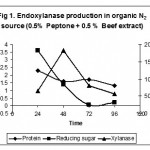 |
Figure 1
|
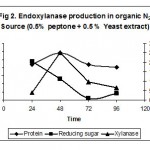 |
Figure 2
|
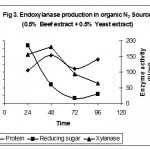 |
Figure 3
|
The different 0.25% organic nitrogen was studied a combination of Peptone and yeast extract (233.0 IU/ml) has given maximum values at 48 hours than other two combinations. The results were represented in figure 4-6.The earlier reports suggests that when nitrogen sources are fed separately, only 60-80% of the existing vities were obtained (Subramaniyan et al., 2001). Peptone usually have 10-15% total nitrogen as the only protein source, but in yeast extract apart from the nitrogen sources, we also comes across 6-17% carbohydrates, amino acids, nucleic acids, etc ( Kelly et al., 1983) The nitrogen sources are having growth stimulatory components, when combined together they resulted in the induction of higher levels of enzyme production. Use of complex nitrogen source like Peptone and Yeast extract would have lead to elevation of the media pH due to the release of excess nitrogen as ammonia, which is growth rate stimulatory (Forage et al., 1985). But here Peptone and Beef extract combination has given better results in the Bacillus culture; there were not many changes in the pH of the medium changed to alkaline side.
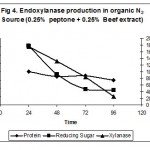 |
Figure 4
|
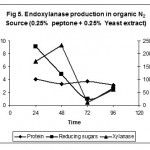 |
Figure 5
|
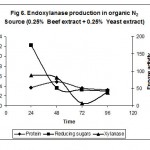 |
Figure 6
|
Effect of Inorganic Nitrogen Sources
Various inorganic nitrogen sources like Ammonium nitrate, Ammonium sulphate, Ammonium chloride, Ammonium Phosphate and Urea at 1mM and 10mM levels were taken and the results were given in Table 1. Only in the case of ammonium sulphate at 1mM level enzyme production was more at 48 hours, but the levels of enzyme activity exhibited were at least 50 times lesser than the activities obtained by organic nitrogen sources. The growth of the Bacillus culture was grown at 10mM, the enzyme production was lesser than that of lower levels of inorganic nitrogen sources. The soluble protein level never got induced with inorganic sources but surprising the reducing sugar level was more in the medium. The experiment shows that endoxylanase production from Bacillus culture required complex organic nitrogen sources. Urea did not show any activities. Similar pattern was reported in the native Bacillus strain also (Subramaniyan et al., 2001).
Table 1: Production of Xylanase from Bacillus culture at different concentration of the selected inorganic nitrogen sources.
| Hours of Incubation | Inorganic N2 Source | 1mM Concentration | 10mM Concentration | ||||
| Protein mg / ml | Reducing Sugars mg / ml | Xylanase IU / ml | Protein mg / ml | Reducing Sugars mg / ml | Xylanase IU / ml | ||
| 24 | NH2NO3 | 0.219 | 0.305 | 3.675 | 0.147 | 0.852 | 2.689 |
| (NH4)2SO4 | 0.171 | 2.653 | 1.271 | 0.170 | 4.557 | 1.892 | |
| NH4CI | 0.140 | 0.155 | 1.795 | 0.122 | 1.148 | 1.142 | |
| NH4PO4 | 0.173 | 2.543 | 4.572 | 0.158 | 3.859 | 1.027 | |
| Urea | 0.155 | 0.976 | 1.242 | 0.144 | 0.136 | 1.611 | |
| 48 | NH2NO3 | 0.213 | 4.493 | 0.341 | 0.213 | 3.633 | 1.653 |
| (NH4)2SO4 | 0.249 | 3.399 | 6.518 | 0.207 | 5.231 | 1.904 | |
| NH4CI | 0.227 | 4.207 | 1.190 | 0.351 | 1.239 | 0.387 | |
| NH4PO4 | 0.336 | 6.041 | 0.662 | 0.197 | 6.231 | 1.050 | |
| Urea | 0.230 | 0.246 | 1.106 | 0.218 | 2.4 | 0.621 | |
| 72 | NH2NO3 | 0.239 | 7.170 | 3.228 | 0.225 | 6.721 | 0.048 |
| (NH4)2SO4 | 0.254 | 6.197 | 11.918 | 0.226 | 7.417 | 3.937 | |
| NH4CI | 0.194 | 7.503 | 3.284 | 1.175 | 8.060 | 10.654 | |
| NH4PO4 | 0.133 | 6.920 | 0.304 | 0.186 | 7.357 | 2.701 | |
| Urea | 0.220 | 3.340 | 0.070 | 0.183 | 6.623 | 1.972 | |
Induction of other Hydrolases in Bacillus
The optimized best organic nitrogen sources, i.e. Peptone and Beef extract at 0.5% and a mixture of the above with ammonium sulphate were incorporated in the growth media to study the induction of other hydrolases like xylanases, proteases and cellulases. The results are given in Table 2.
Table 2: Induction of other Hydrolases from Bacillus culture grown with organic and Organic + Inorganic nitrogen sources.
| Hours of Incubation | Xylanase (IU / ml) | Protease (IU / ml) | Cellulase (IU / ml) | |||
| Organic | Organic + Inorganic | Organic | Organic + Inorganic | Organic | Organic + Inorganic | |
| 24 | 31.4 | 32.7 | 16.2 | 14.3 | 2.3 | 0.1 |
| 48 | 252.4 | 229.8 | 27.4 | 24.5 | 8.2 | 4.5 |
| 72 | 85.6 | 121.6 | 27.7 | 23.2 | 5.3 | 4.7 |
| 96 | 55.7 | 75.2 | 15.3 | 15.1 | 4.9 | 3.9 |
| 120 | 39.4 | 42.3 | 10.1 | 11.3 | 1.1 | 0.3 |
The results indicated that in the presence of organic sources, the protease induction was more than that with the mixture of organic and inorganic nitrogen sources. The cellulase production pattern also have similar trend. Cellulase production in the culture was very negligible in comparison with the endoxylanase production during the mixture of optimum nitrogen sources. Presence of sulphate in the medium normally induced endoxylanase production (Gilbert and Hazel wood 1993). When ammonium sulphate was given alone it triggered the enzymes production better than the other ammonium salts.
Conclusion
The enzyme of endoxylanase, which is used for the degradation as hetero polysaccharide is increased in Bacillus sp by providing both organic and inorganic nitrogen sources in different concentration. Of these organic nitrogen sources (i.e. 0.25% Peptone + 0.25%% Beef extract) showed better enzyme production. Similarly, inorganic nitrogen sources in the form of Ammonium sulphate 1mM also showed better results. The optimal nitrogen sources were also tried for the induction of other hydrolases like cellulases, xylanases and proteases, the other two enzymes were expressed in low level except xylanases.
References
- Conghlan, M.P. and G.P.Hazelwood, 1993. b-1,4-D-xylan-degrading enzyme systems :
- biochemistry, molecular biology and applications. Biotechnol. Appl. Biochem., 17:259-289.
- Forage, R.G., D.H.F. Harrison and D.E.Pitt, 1985. Effect of environment on microbial
- activity In : Moo – Young M, Bull AT, Dalton H (Eds.) Comprehensive Biotechnology. The principles, application and regulation of Biotechnology in Industry, agriculture and medicine. Oxford: Pergamon Press Pp. 251-280.
- Ghose, T.K., 1987. Measurement of cellulose activities. Pure and Applied chem.,59 (2) : 257 – 268.
- Gilbert, H.J. and G.P. Hazelwood, 1993. Bacterial cellulases and xylanases.
- J.Gen.Microbial., 139 : 187.
- Kelly, M. 1983. Yeast extract In:Goddrey, T. Reichelt, J (Eds) Industrial Enzymology,
- New York, M. Stocklon press, Pp. 457-465.
- Lowry, O.H., N.J. Rosenbrogh, A.L. Farr and R.L. Randall, 1951. Protein measurement
- with Folin – phenol reagent. J.Biol. Chem., 193: 265 – 275.
- Miller, G.L., 1959. Use of dinitrosalycylic acid reagent for determination of reducing
- sugars. Anal. Chem.,31: 426 – 428.
- Tsuchicla.O., Y.Yamagata, T.Ishimuka, T.Arai, Y.Yamada, M.Takenchi and
- E.Ichishima, 1986. An alkaline proteinase of an alklophilic Bacillus sp.Curr. Microbial., 14 : 7 – 12.
- Subraniyan, S., G.S. Sandhiya and P.Prem, 2001. Control of xylanase production without protease activity in Bacillus sp by selation of nitrogen source. Biotech 23.369-371.

This work is licensed under a Creative Commons Attribution 4.0 International License.





